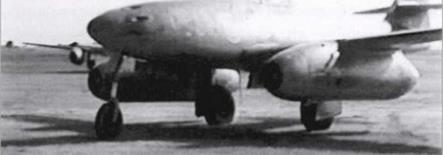Jet Fighters
|
T |
he end of the era of the piston-engined fighter coincided with the end of the Second World War. In the second half of 1944 the Luftwaffe turned its hopes increasingly to the twin-turbine Me 262 A-la jet fighter. Even though only relatively few Geschwader enjoyed its use, that does nothing to alter the fact that in 1945 this machine was the fastest jet fighter in the world to be operational in large numbers.
Me 262 A-la
The introduction of the Me 262 jet was hindered initially by reverses. The BMW turbines failed to live up to their promise. Even the change-over to Jumo 004 T-ls and T-2s brought no quick breakthrough. General der Jagd-
|
|
The Luftwaffe believed that the Me 262 A-la would revolutionise air warfare. Production in fits and starts prevented the deployment of the jet fighter in the numbers desired by OKL.
flieger Adolf Galland declared the machine ready for operations after his trial flight in the V-4 prototype, but the euphoria was soon dispelled when the new technology with all its attendant problems delayed completion and delivery of the first pre-series run into the spring of 1944. During testing new defects came to light almost daily, causing ever more postponements. New delays followed the Blitzbomber idea which had been accepted without protest by Goring, and on 25 May 1944 the aircraft was transferred to the jurisdiction of the General der Kampfflieger for future use mainly as a fighter-bomber.
Nevertheless the development of the single-seat fighter was continued. In December 1943 a test commando had been established at Lechfeld and from May 1944 the pilots of III./ZG 26 underwent conversion training for jets. Although one of the most influential advocates of the Me 262, Hauptmann Thierfelder, was shot down in his machine, the first victories were achieved during the operational testing period. On 26 September 1944 Kommando Nowotny was founded. Major Walter Nowotny and his pilots proved from 8 August 1944 how efficient the Me 262 A-la was in aerial combat: Nowotny himself, a highly decorated commander, lost his life when shot down on 8 November 1944. Before being incorporated into JG 7, the Kommando obtained at least 17 victories.
Despite great efforts, the number of Me 262s available remained small. This was because of the advanced technology and the air raids on the assembly lines at Augsburg. The relocation of these to forests, or the construction of underground assembly facilities were both necessary, but meant fewer aircraft being produced than originally planned. Even at the end of the war the relocation of plants for Me 262 A-la assembly was incomplete. Delays in the delivery of new aircraft to individual units in the spring of 1945 prevented a smooth changeover to the Me 262, and OKL succeeded in equipping only a few fighter Gruppen, especially those ofJG 7 and KG(J) 54, with reasonable numbers.











